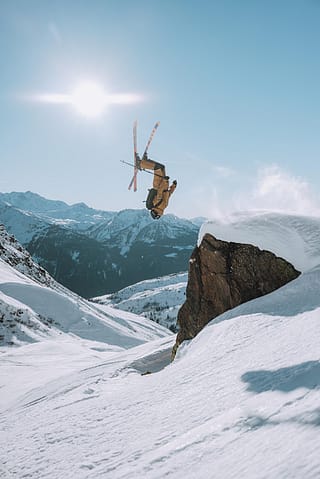What is heli-skiing?
If you know what heli-skiing is, you already know it’s a pretty spectacular pastime. But how did the sport come about, and more importantly, can you do it too?

If slashing untouched powder on high Alaskan peaks makes you feel a little excited, then heli-skiing might just be the extreme sport for you. When the resort just doesn’t cut it anymore, venturing into the backcountry in a chopper and seeking out some burly lines may very well be the next step. But before you book a trip, there are a few things to know.
Heli-skiing probably has a longer history than you realize. And while companies certainly do their utmost to ensure the safety of their passengers, it’s still an extremely dangerous sport. So, who’s it suited for, then? You might be glad to know that you don’t need to be a pro to go heli-skiing. Even so, read this article before you make up your mind!
And if you decide to take the plunge, you’ll need some appropriate gear! Check out our range of heli-ready ski jackets and ski pants and experience the MONTEC standard in backcountry riding.
Quick find navigation
Heli-skiing definition
Heli-skiing is the act of boarding a helicopter and venturing into the backcountry. The helicopter will touch down on an otherwise inaccessible peak and drop you off. From here, you ski down the face to the bottom, where the helicopter will pick you up and take you to the top again.
We’re not making that sound very fun, but we assure you, it’s about as exciting as things get! And, depending on your riding level, the number of people in your group, where you’re skiing, the conditions, and the package you’ve opted for, your experience might vary wildly.
Avalanches and cornices are two of the biggest threats while heli-skiing. So, for less experienced riders, areas with lowered risk of sloughing and breakaways will be selected — generally mellower gradients. More experienced riders can access steeper, riskier terrain if the conditions permit!

What’s the history of heli-skiing?
Heli-skiing dates back as far as the 50s. While it’s pretty much agreed that Hans Gmoser, an Austrian immigrant to Canada in the early 50s, is the ‘father’ of heli-skiing, the initial idea came from a Canadian geologist named Art Patterson. Patterson used helicopters to travel into the remote reaches of the Canadian mountain ranges during the summers, but realized there was little use for them once the snow built up. As an enthusiastic skier, he wondered if there was a way to utilize helicopters to further his love of the sport.
He teamed up with Gmoser, an experienced mountain guide, and founded a business together. As they only had a small and unreliable Bell 47 chopper, Patterson deemed the whole venture too risky and withdrew from the business. Gmoser pushed on, growing and nurturing the business, eventually founding CMH (Canadian Mountain Holidays) in 1965, which remains the largest heli-ski company in the world.
Gmoser focused on building mountain lodges, growing a fleet of helicopters and experienced pilots, and expanding into mountain ranges outside the Columbias, where they began. The company continued to grow through the 70s and 80s, and heli-skiing quickly became a worldwide phenomenon.

Where can you heli-ski?
You can heli-ski most places that have snow. Of course, that’s a vast oversimplification, but it’s not far from the truth. You'll generally find resorts anywhere there’s enough snow to ski.
Heli-skiing comes into its own when there’s lots of snow and great terrain, but access is difficult or impossible. This is why heli-skiing is so popular in places like the Alaskan and Canadian Rockies, the Sierra Nevada, the Himalayas, the Andes, the Caucasus Mountains, and so much more!
Heli-skiing opens up the world to be ridden, but there are certainly hot spots that attract riders. With many companies operating out of popular destinations, pilots can build a knowledge base of where is safe, reliable, and most importantly, offers the best experience! As this is such a dangerous sport, pilots must prioritize safety, and you’ll be glad to know they always do.
Heli-skiing Alaska

If you’re heading north to Alaska (to the unofficial mecca of heli-skiing), there are a few great options available. The Tordrillo Mountains are regarded as the most reliable and sought-after location. This is because they offer 1.2 million acres of skiable terrain, over 600 inches (50 feet!) of snow per year, and elevations running as high as 7,500 ft with verticals as long as 5,500 ft.
Well-mapped and always monitored, the Tordrillo Mountains have everything from mind-blowing steeps and chutes to mellower powder fields. These help make the place one giant playground suited to a varied range of riders.
Alternatively, the Chugach Range near Valdez, and the Cordova region, are extremely popular choices. In the Chugach Range, the peaks get as high as 13,000 ft but average around 4,000 ft. However, this lower elevation is offset by the fact that it has the highest snowfall in the world, with an 800-inch yearly average. That’s 67 feet of snow! So there’s plenty of powder to be discovered, lots of laps to be had, and the benefit of staying out of some of the bad weather that hits higher up. The Cordova region is much the same, with slightly lower snowfall (still more than 50 ft), but just as much fun to be had.
Heli-skiing Canada

Heli-skiing in Canada is more of the same! Again, you’re spoilt for choice here, but we definitely recommend the west coast for the snow and terrain. There are a lot of different locations on offer, all averaging over 25 ft of snow per year, so there’s really no way to go wrong.
To the southeast, you can access the Kootenays, the Valhallas, the Goat Range, and the Purcell mountains to get your thrills, with lots of high-alpine, tree-filled runs. Further north, you’ll close in on the Columbia Range, the Bugaboos (where heli-skiing was born), and get into the Rockies. Elevations are higher here, and you’ll begin to get above the treeline for more of that classic Alaskan-style heli-skiing.
Even further north, you’ll hit the Rockies, and opportunities become a little more sparse. But to the east, there’s lots of fun to be found in the Monashees. And out towards the coast, the North Cascades offer plenty of thrills. Finally, north of Vancouver, you’ll be treated to the Bastion Range and Clendenning Range. Here, you’ll find plenty of opportunities to ski Powder Mountain, and Whistler and Blackcomb. And, if you choose the right operator, you can ride some seriously ambitious terrain. Or, if you want to keep it more mellow, there’s a lot of accessible terrain for the less adventurous rider, too.
Other top heli-skiing destinations

The Alps is another amazing heli-skiing destination. With so much high terrain and a vast ski area, numerous operators run trips out of France, Switzerland, and Austria. Heli-skiing is definitely on offer in the lower 48, too. You can find heli-skiing around the major resorts from Utah to Colorado and Nevada to California, opening up some amazing inaccessible terrain.
Outside of the US, more niche operators run trips in the Andes, the Himalayas, and the Caucasus mountains. Though they’re tougher to get to, a Himalayan heli-ski trip would be one for the history books!
However, if you’d like to ski Asia, Japan offers a good selection of low-altitude heli-skiing — especially if it’s neck-deep powder that excites you. And, honestly, why wouldn’t it?
FAQs
What's the difference between heli-skiing and cat skiing?
Heli-skiing involves a helicopter, and cat skiing means riding a snow cat to the top of the mountain. Both offer curated experiences and untouched powder laps, but helicopters will go where cats can’t.
Do you need special equipment?
Powder skis, avalanche packs and gear (probes, beacon/transponder), appropriate skiwear, and a strong set of legs.
What should you take heli-skiing?
You’ll definitely want to take avalanche gear, along with good-quality, powder-focused equipment. And a pack with spare clothing and layers, water, and food. It’s always a long day on the mountain!
Should you have avalanche safety qualifications for heli-skiing?
While not all operators require it, we’d always recommend having your AST 1 at the very least before venturing beyond the resort.

How good of a skier do you need to be to heli-ski?
Advanced-expert is the benchmark. If the thought of heli-skiing makes you nervous, you’re probably not there yet! Terrain is often steep and unpredictable, and powder gets very deep and soft, so you need to be in full control and confident at speed, or you might get into trouble!
Is heli-skiing expensive?
Yes. It’s generally an expensive hobby, but the price can be offset by booking a group trip, jumping on early or late-season deals, or looking for cancellations.
Is heli-skiing safe?
If you’re smart, yes, it’s safe. As safe as normal skiing, anyway. Tour operators do their utmost to ensure safety by selecting stable terrain and running trips in good weather. Even so, take your time and be cautious. Anything can happen in the backcountry.
Wrapping up
There you have it, your guide to heli-skiing. Whether you already knew or didn’t, now you do! So, get out there and book your AST 1, start hunting down some pow skis, and get saving because winter is always just around the corner, and there’s no time like the present!
Like this article, want to get in touch or know something we don’t? Reach out to us!
Related Reading:
